Assessing the Impact of Future Sea Level Rise on Blue Carbon Ecosystem Services on Long Island, New York
Abstract
1. Introduction
2. Materials and Methods
2.1. Study Area
2.2. Sea Level Rise Inputs
2.3. Coastal Blue Carbon Ecosystem Service Model
2.4. Net Present Value of Carbon Sequestration
3. Results
4. Discussion
5. Conclusions
Supplementary Materials
Author Contributions
Funding
Institutional Review Board Statement
Informed Consent Statement
Data Availability Statement
Acknowledgments
Conflicts of Interest
References
- IPCC. Climate Change 2021: The Physical Science Basis. Contribution of Working Group I to the Sixth Assessment Report of the Intergovernmental Panel on Climate Change Masson-Delmotte; Zhai, P., Pirani, A., Connors, S., Péan, C., Berger, S., Caud, N., Chen, Y., Goldfarb, L., Gomis, M., Huang, M., et al., Eds.; Cambridge University Press: Cambridge, UK, 2021. [Google Scholar] [CrossRef]
- Minx, J.C.; Lamb, W.F.; Callaghan, M.W.; Fuss, S.; Hilaire, J.; Creutzig, F.; Dominguez, M.D.M.Z. Negative emissions—Part 1: Research landscape and synthesis. Environ. Res. Lett. 2018, 13, 063001. [Google Scholar] [CrossRef]
- Mcleod, E.; Chmura, G.L.; Bouillon, S.; Salm, R.; Björk, M.; Duarte, C.M.; Silliman, B.R. A blueprint for blue carbon: Toward an improved understanding of the role of vegetated coastal habitats in sequestering CO2. Front. Ecol. Environ. 2011, 9, 552–560. [Google Scholar] [CrossRef] [PubMed]
- Smith, A.J.; Kirwan, M.L. Sea-level driven marsh migration results in rapid net loss of carbon. Geophys. Res. Lett. 2021, 48, e2021GL092420. [Google Scholar] [CrossRef]
- Duarte, C.M.; Middelburg, J.J.; Caraco, N. Major role of marine vegetation on the oceanic carbon cycle. Biogeosciences 2005, 2, 1–8. [Google Scholar] [CrossRef]
- Wang, F.; Sanders, C.J.; Santos, I.R.; Tang, J.; Schuerch, M.; Kirwan, M.L.; Li, Z.A. Global blue carbon accumulation in tidal wetlands increases with climate change. Natl. Sci. Rev. 2021, 8, nwaa296. [Google Scholar] [CrossRef] [PubMed]
- Windham-Myers, L.; Crooks, S.; Troxler, T.G. A Blue Carbon Primer: The State of Coastal Wetland Carbon Science, Practice, and Policy; CRC Press: Boca Raton, FL, USA, 2019. [Google Scholar]
- Herr, D.; von Unger, M.; Laffoley, D.; McGivern, A. Pathways for implementation of blue carbon initiatives. Aquat. Conserv. Mar. Freshw. Ecosyst. 2017, 27, 116–129. [Google Scholar] [CrossRef]
- Wedding, L.M.; Moritsch, M.; Verutes, G.; Arkema, K.; Hartge, E.; Reiblich, J.; Strong, A.L. Incorporating blue carbon sequestration benefits into sub-national climate policies. Glob. Environ. Chang. 2021, 69, 102206. [Google Scholar] [CrossRef]
- Fagherazzi, S.; Anisfeld, S.C.; Blum, L.K.; Long, E.V.; Feagin, R.A.; Fernandes, A.; Williams, K. Sea level rise and the dynamics of the marsh-upland boundary. Front. Environ. Sci. 2019, 7, 25. [Google Scholar] [CrossRef]
- Rogers, K.; Kelleway, J.J.; Saintilan, N.; Megonigal, P.; Adams, J.B.; Holmquist, J.R.; Lu, M.; Schile-Beers, L.; Zawadzki, A.; Mazumder, D.; et al. Wetland carbon storage controlled by millennial-scale variation in relative sea-level rise. Nature 2019, 567, 91–95. [Google Scholar] [CrossRef] [PubMed]
- Warnell, K.; Olander, L.; Currin, C. Sea level rise drives carbon and habitat loss in the US mid-Atlantic coastal zone. PLoS Clim. 2022, 1, e0000044. [Google Scholar] [CrossRef]
- zu Ermgassen, P.S.; Baker, R.; Beck, M.W.; Dodds, K.; zu Ermgassen, S.O.; Mallick, D.; Turner, R.E. Ecosystem services: Delivering decision-making for salt marshes. Estuaries Coasts 2021, 44, 1691–1698. [Google Scholar] [CrossRef]
- Osland, M.J.; Chivoiu, B.; Enwright, N.M.; Thorne, K.M.; Guntenspergen, G.R.; Grace, J.B.; Swarzenzki, C.M. Migration and transformation of coastal wetlands in response to rising seas. Sci. Adv. 2022, 8, eabo5174. [Google Scholar] [CrossRef] [PubMed]
- Dewitz, J. National Land Cover Database (NLCD) 2016 Products: U.S. Geological Survey Data Release; USGS: Washington, DC, USA, 2019. [CrossRef]
- Drake, K.; Halifax, H.; Adamowicz, S.; Craft, C. Carbon sequestration in tidal salt marshes of the northeast United States. Environ. Manag. 2015, 56, 998–1008. [Google Scholar] [CrossRef] [PubMed]
- Moritsch, M.M.; Young, M.; Carnell, P.; Macreadie, P.I.; Lovelock, C.; Nicholson, E.; Raimondi, P.T.; Wedding, L.M.; Ierodiaconou, D. Estimating blue carbon sequestration under coastal management scenarios. Sci. Total Environ. 2021, 777, 145962. [Google Scholar] [CrossRef] [PubMed]
- Ouyang, X.; Lee, S.Y. Updated estimates of carbon accumulation rates in coastal marsh sediments. Biogeosciences 2014, 11, 5057–5071. [Google Scholar] [CrossRef]
- Wagner, G. Recalculate the social cost of carbon. Nat. Clim. Chang. 2021, 11, 293–294. [Google Scholar] [CrossRef]
- NYS Department of Environmental Conservation. Establishing a Value of Carbon: Guidelines for Use by State Agencies. 2022. Available online: https://www.dec.ny.gov/docs/administration_pdf/vocguid22.pdf (accessed on 24 February 2023).
- Interagency Working Group on the Social Cost of Greenhouse Gases. Technical Support Document: Technical Update of the Social Cost of Carbon for Regulatory Impact Analysis-under Executive Order 12866. Environmental Protection Agency. Available online: https://www.epa.gov/sites/default/files/2016-12/documents/sc_co2_tsd_august_2016.pdf (accessed on 3 February 2023).
- Coastal Carbon Atlas. Available online: https://serc.si.edu/coastalcarbon (accessed on 31 January 2023).
- Holmquist, J.R.; Schile-Beers, L.; Buffington, K.; Lu, M.; Mozdzer, T.J.; Riera, J.; Megonigal, J.P. Scalability and performance tradeoffs in quantifying relationships between elevation and tidal wetland plant communities. Mar. Ecol. Prog. Ser. 2021, 666, 57–72. [Google Scholar] [CrossRef]
- Feagin, R.A.; Martinez, M.L.; Mendoza-Gonzalez, G.; Costanza, R. Salt marsh zonal migration and ecosystem service change in response to global sea level rise: A case study from an urban region. Ecol. Soc. 2010, 15, 14. [Google Scholar] [CrossRef]
- Watson, E.B.; Raposa, K.B.; Carey, J.C.; Wigand, C.; Warren, R.S. Anthropocene survival of southern New England’s salt marshes. Estuaries Coasts 2017, 40, 617–625. [Google Scholar] [CrossRef] [PubMed]
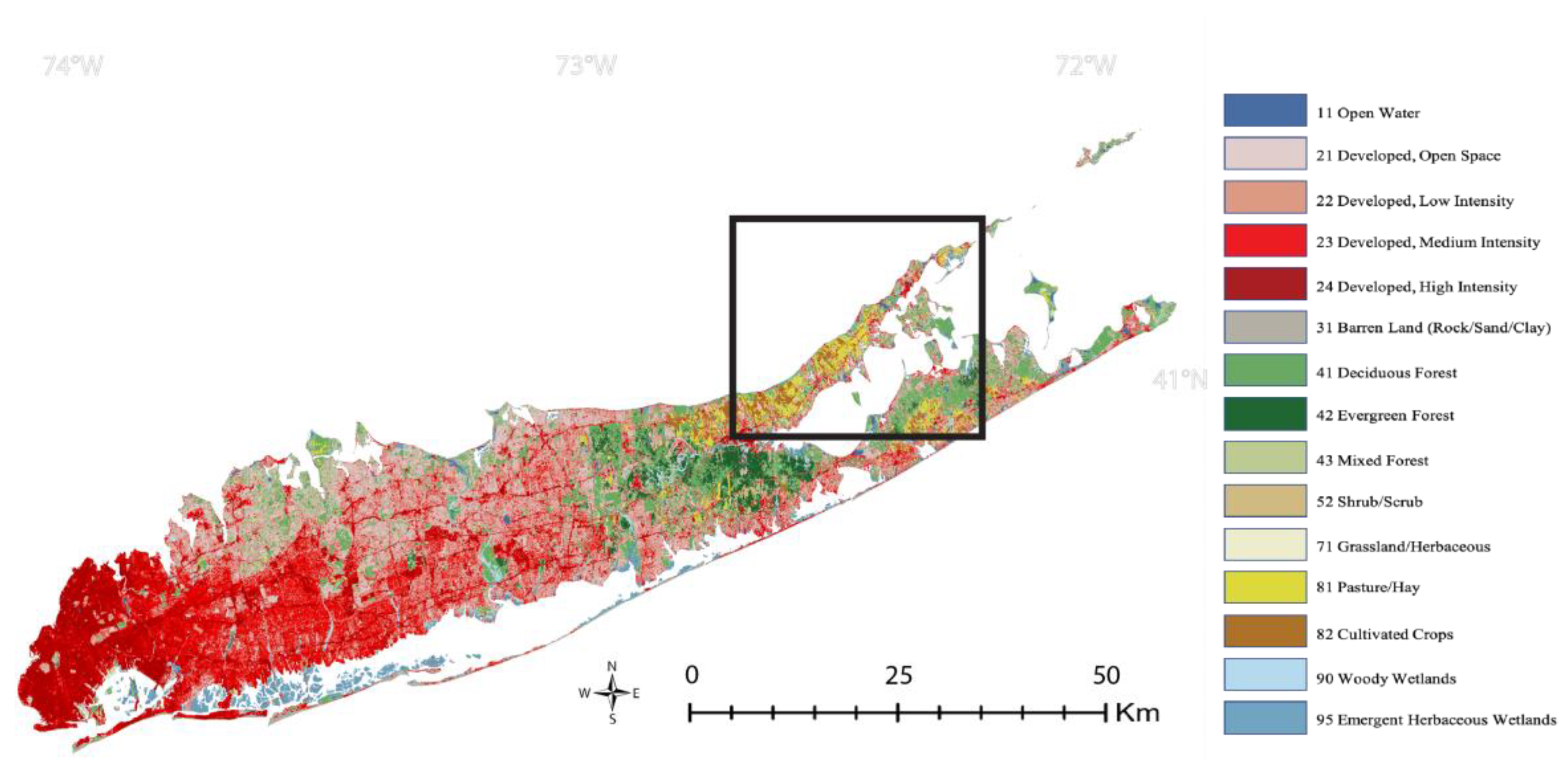
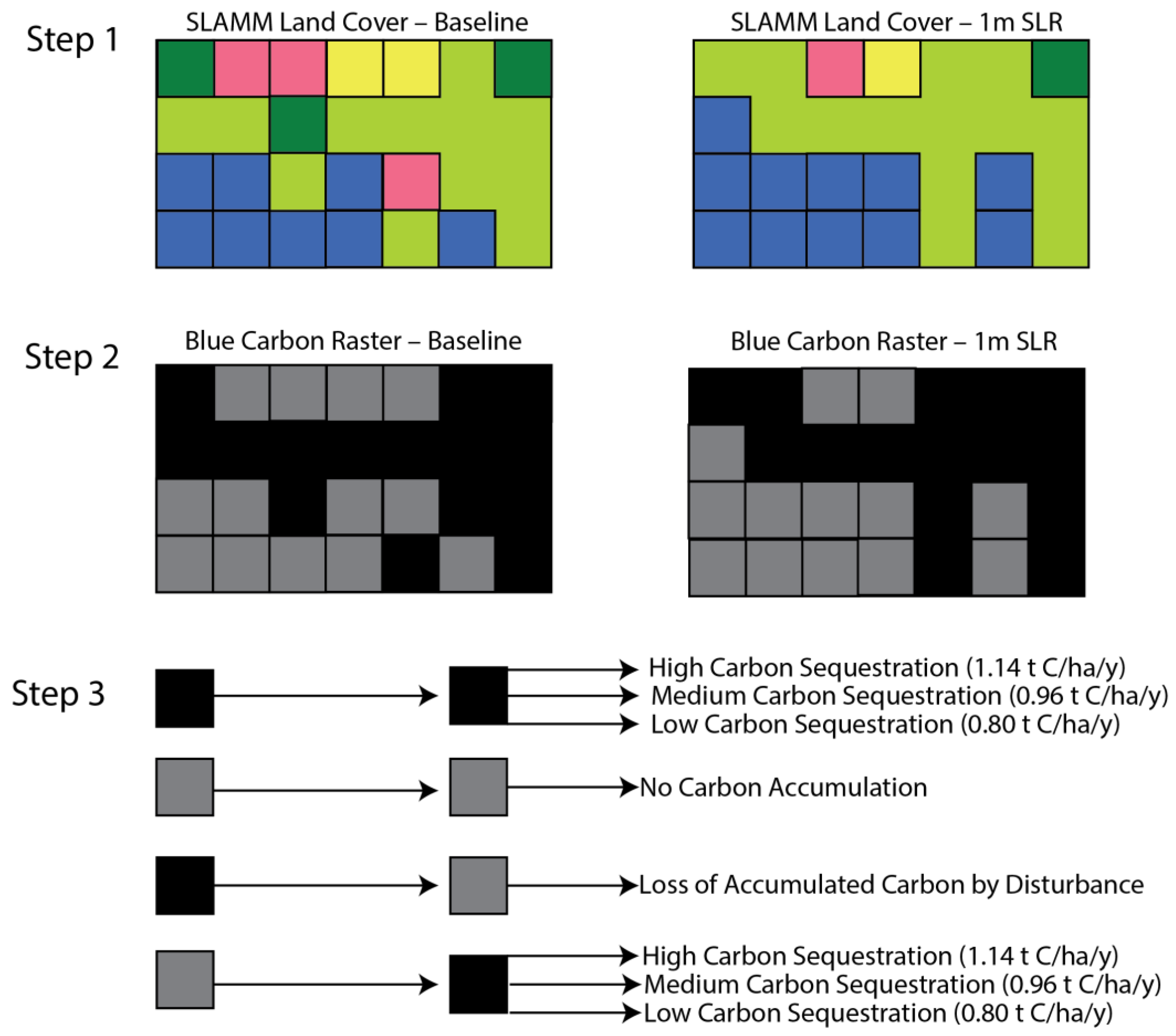
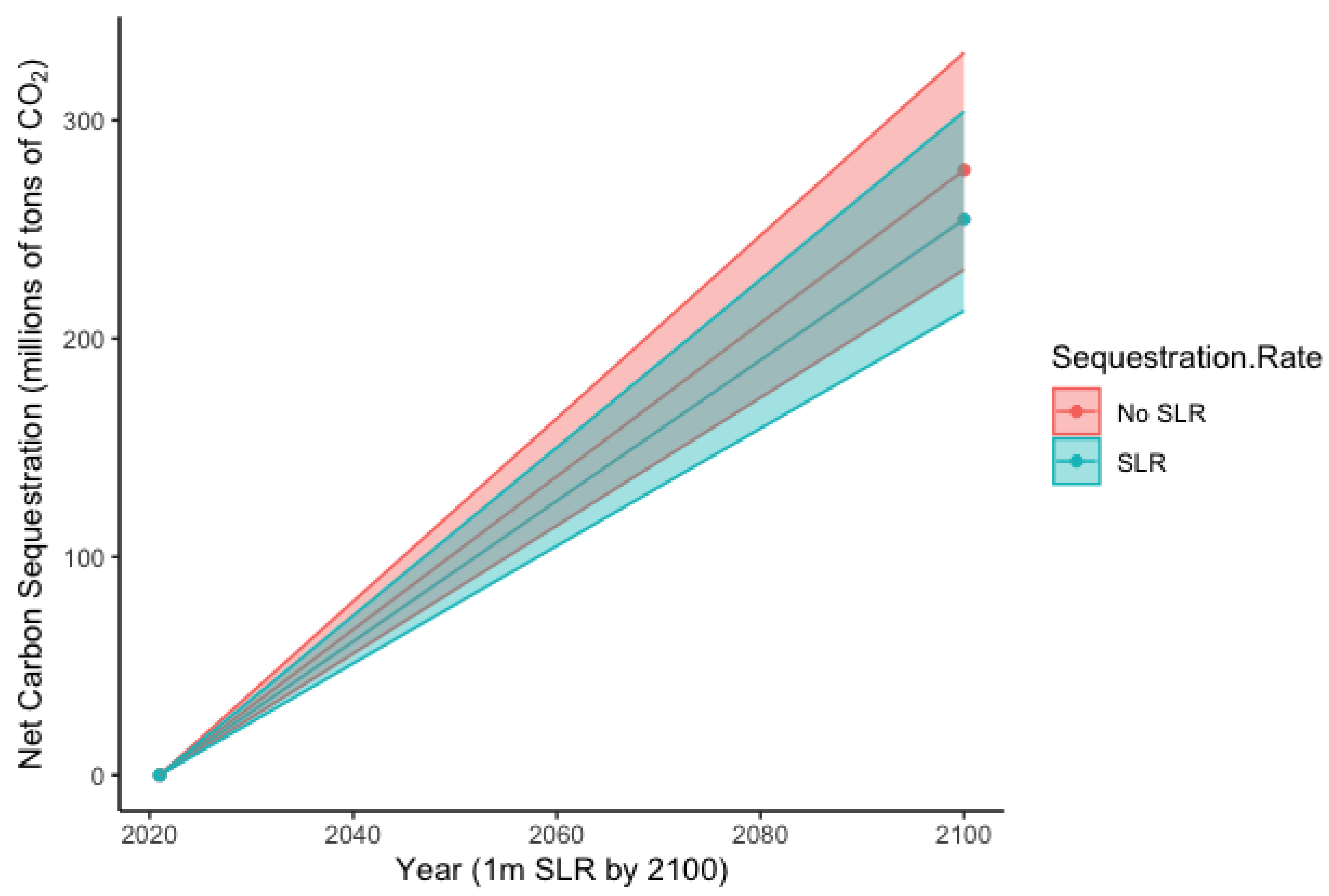

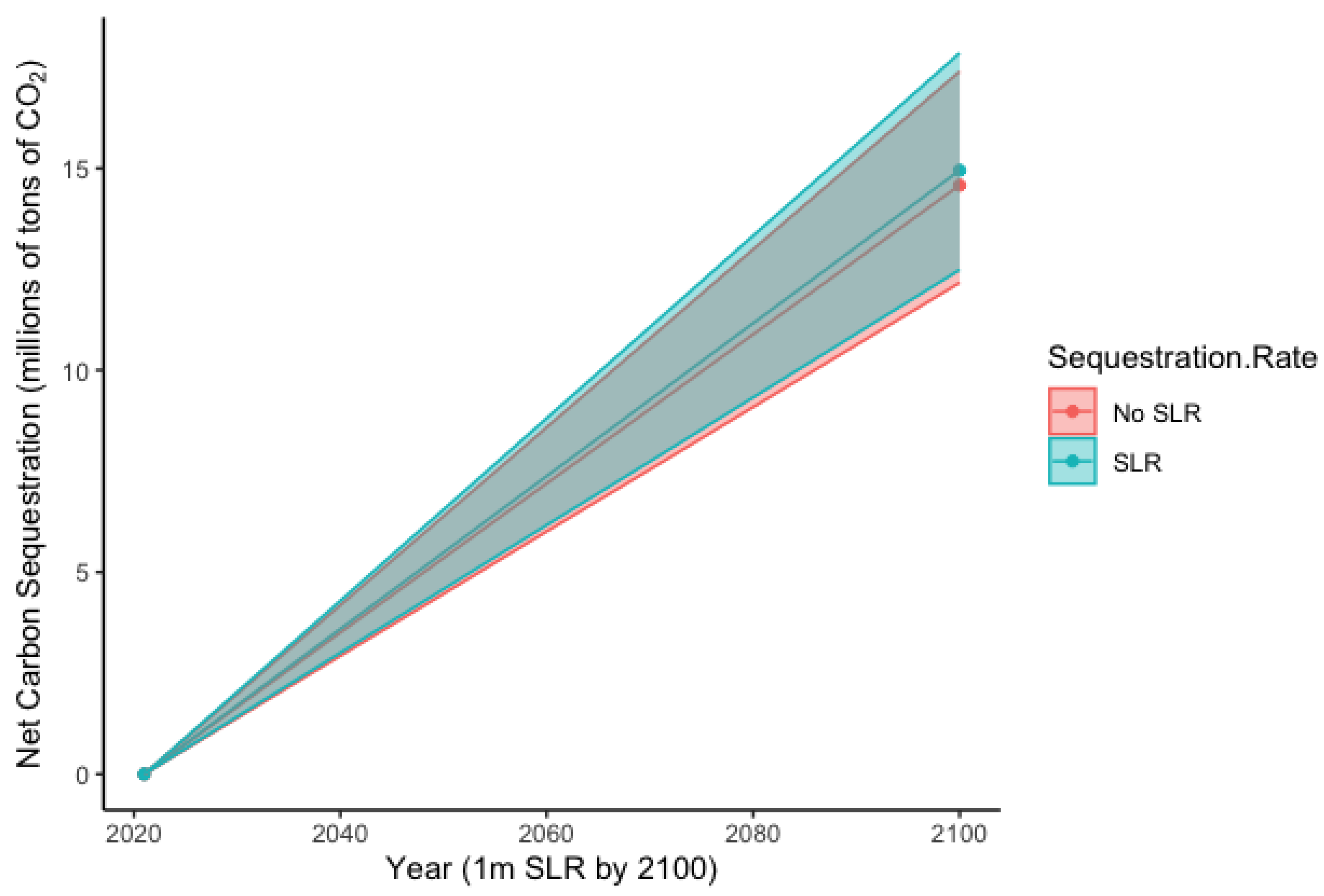
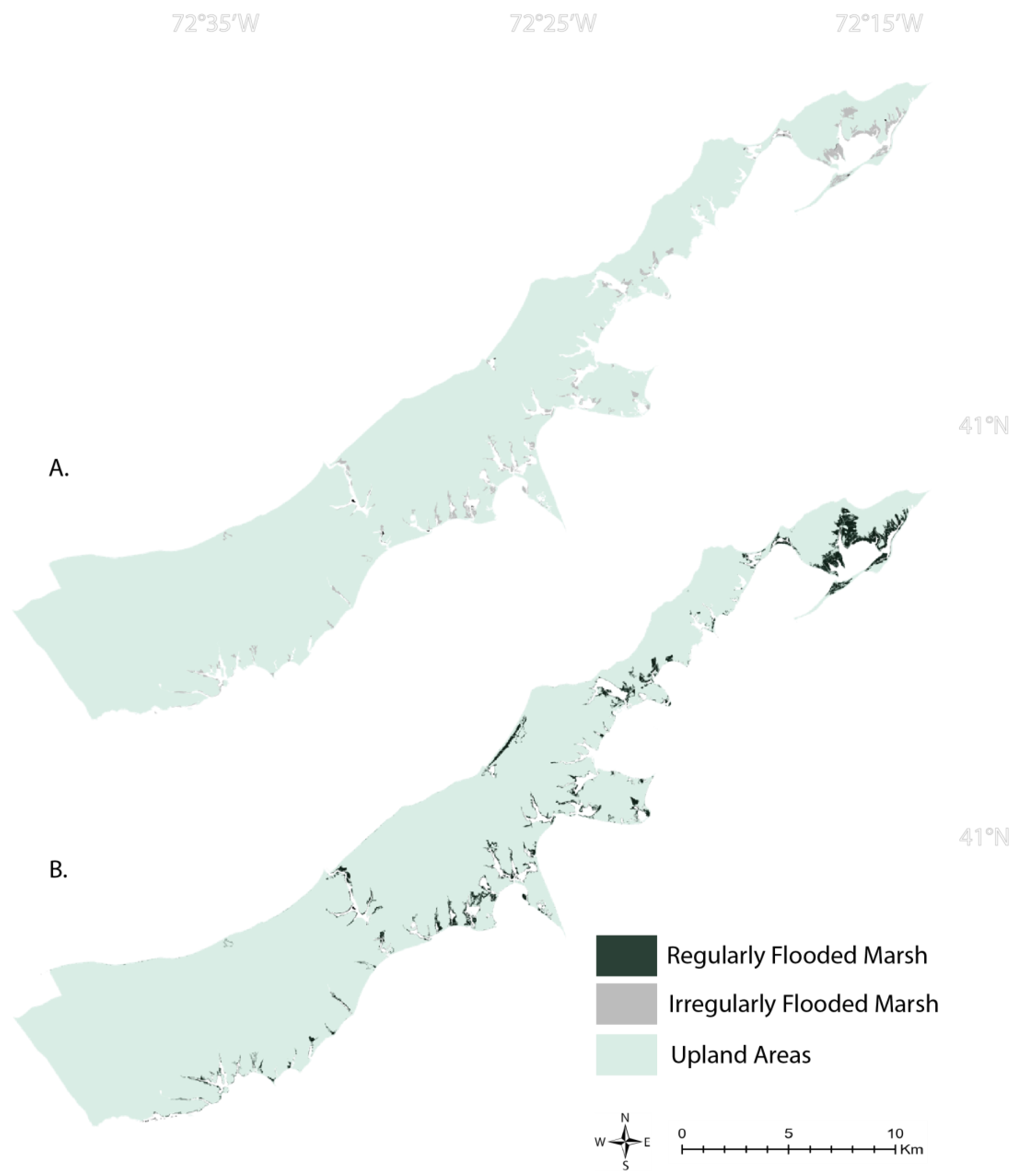
| Code | SLAMM Land Cover Classification |
|---|---|
| 1 | Developed Dry Land (upland) |
| 2 | Undeveloped Dry Land (upland) |
| 3 | Nontidal Swamp |
| 4 | Cypress Swamp |
| 5 | Inland Fresh Marsh |
| 6 | Tidal Fresh Marsh |
| 7 | Traditional Marsh/Scrub Shrub |
| 8 | Regularly Flooded Marsh (Saltmarsh) |
| 9 | Mangrove |
| 10 | Estuarine Beach |
| 11 | Tidal Flat |
| 12 | Ocean Beach |
| 13 | Ocean Flat |
| 14 | Rocky Intertidal |
| 15 | Inland Open Water |
| 16 | Riverine Tidal Open Water |
| 17 | Estuarine Open Water |
| 18 | Tidal Creek |
| 19 | Open Ocean |
| 20 | Irregularly Flooded Marsh |
| 21 | Not Used |
| 22 | Inland Shore |
| 23 | Tidal Swamp |
| 24 | Blank |
| 25 | Flooded Developed Dry Land |
| 26 | Flooded Forest |
| SLR Scenario | Sequestration Rate Value | Total Net Carbon Sequestration 2021–2100 (Millions of Tons of CO2) | Net Present Value (Millions of USD) |
|---|---|---|---|
| 1 m | Low | 212.7 | $265,000 |
| 1 m | Medium | 254.7 | $317,000 |
| 1 m | High | 304.0 | $378,000 |
| No SLR | Low | 231.6 | $377,900 |
| No SLR | Medium | 277.3 | $452,400 |
| No SLR | High | 331.1 | $540,100 |
| SLR Scenario | Sequestration Rate Value | Total Net Carbon Sequestration 2021–2100 (Millions of Tons of CO2) | Net Present Value (Millions of USD) |
|---|---|---|---|
| 1 m | Low | 12.5 | $18,700 |
| 1 m | Medium | 15.0 | $22,400 |
| 1 m | High | 17.9 | $26,720 |
| No SLR | Low | 12.2 | $19,900 |
| No SLR | Medium | 14.6 | $23,800 |
| No SLR | High | 17.4 | $28,400 |
Disclaimer/Publisher’s Note: The statements, opinions and data contained in all publications are solely those of the individual author(s) and contributor(s) and not of MDPI and/or the editor(s). MDPI and/or the editor(s) disclaim responsibility for any injury to people or property resulting from any ideas, methods, instructions or products referred to in the content. |
© 2023 by the authors. Licensee MDPI, Basel, Switzerland. This article is an open access article distributed under the terms and conditions of the Creative Commons Attribution (CC BY) license (https://creativecommons.org/licenses/by/4.0/).
Share and Cite
Tanner, K.; Strong, A.L. Assessing the Impact of Future Sea Level Rise on Blue Carbon Ecosystem Services on Long Island, New York. Sustainability 2023, 15, 4733. https://doi.org/10.3390/su15064733
Tanner K, Strong AL. Assessing the Impact of Future Sea Level Rise on Blue Carbon Ecosystem Services on Long Island, New York. Sustainability. 2023; 15(6):4733. https://doi.org/10.3390/su15064733
Chicago/Turabian StyleTanner, Katherine, and Aaron L. Strong. 2023. "Assessing the Impact of Future Sea Level Rise on Blue Carbon Ecosystem Services on Long Island, New York" Sustainability 15, no. 6: 4733. https://doi.org/10.3390/su15064733
APA StyleTanner, K., & Strong, A. L. (2023). Assessing the Impact of Future Sea Level Rise on Blue Carbon Ecosystem Services on Long Island, New York. Sustainability, 15(6), 4733. https://doi.org/10.3390/su15064733





